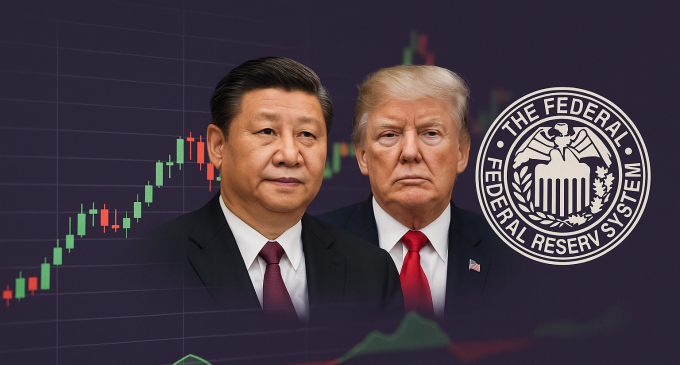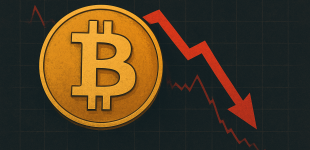
Introduction
The global cryptocurrency market has entered one of the most important weeks of the year, with several critical events converging to shape the direction of prices. As Bitcoin and Ethereum consolidate near record highs, all eyes are on diplomatic talks between the United States and China and the Federal Reserve’s upcoming policy decision. The outcome of these developments could determine whether the ongoing rally continues or faces a sharp correction.
Consolidation At The Top
Bitcoin remains steady around the 114,000-dollar level, while Ethereum trades near 4,100 dollars. After weeks of strong gains, both assets are showing signs of consolidation, suggesting traders are cautious and waiting for new catalysts. The crypto market as a whole appears to be at an inflection point, balancing optimism from positive macro signals against the risk of disappointment if upcoming events fail to deliver.
This consolidation represents a moment of reflection for investors. The question is not whether the rally has been strong, but whether it has the strength to continue without new sources of momentum.
Key Drivers Behind Market Sentiment
U.S.–China Diplomacy
The long-awaited meeting between former U.S. President Donald Trump and Chinese President Xi Jinping is being closely watched by investors worldwide. The two leaders are expected to discuss trade relations and tariffs at the upcoming APEC Summit in Seoul. Markets are pricing in a high probability of a tariff agreement, but expectations are more muted regarding the lifting of China’s rare-earth export restrictions.
For cryptocurrency traders, the implications of this meeting go beyond geopolitics. A positive outcome could boost risk appetite globally, encouraging more investment in high-volatility assets like Bitcoin and Ethereum. Conversely, a lack of progress or renewed trade tensions could quickly dampen enthusiasm and lead to profit-taking across digital assets.
Federal Reserve Policy and Liquidity Outlook
Another major factor shaping the market is the Federal Reserve’s upcoming policy decision. Investors are speculating that the Fed might signal the end of its three-year quantitative tightening program, which has been steadily reducing liquidity in financial markets. Even the possibility of pausing balance-sheet reductions could fuel a new wave of optimism for risk assets, including crypto.
If the Fed hints at policy easing or a return to balance-sheet expansion, liquidity expectations would rise significantly. Since cryptocurrency markets have historically thrived in high-liquidity environments, such a shift could provide the spark for a new leg up in prices.
However, if the central bank maintains a cautious or hawkish tone, it could lead to renewed market pressure, with traders adjusting their positions accordingly.
The Macro Backdrop
The broader macro environment adds additional complexity. The U.S. government shutdown, now stretching into several weeks, has delayed economic data releases and clouded visibility for policymakers and investors alike. Meanwhile, upcoming earnings reports from major technology companies such as Apple, Microsoft, Amazon, and Alphabet will offer clues about consumer demand and corporate health.
Crypto markets, though technically independent from traditional finance, often respond to shifts in sentiment across equities and bonds. Strong tech earnings could reinforce the narrative that the global economy remains resilient, while weak results may undermine risk appetite across all asset classes.
What Traders Are Watching Closely?
1. The Trump–Xi Outcome
A successful trade agreement between the U.S. and China could inject optimism into global markets and reinforce the bullish case for crypto. Traders are particularly attentive to whether the summit produces tangible commitments or simply symbolic gestures. The difference could decide whether Bitcoin breaks higher or retreats from its current plateau.
2. The Fed’s Balance-Sheet Policy
Crypto investors will analyze every word of the Fed’s statement for clues about liquidity conditions. A dovish tilt would be interpreted as bullish for Bitcoin and Ethereum, while any sign of ongoing tightening could trigger a sell-off.
3. Technical Levels and Market Psychology
From a technical perspective, Bitcoin faces a crucial resistance near 116,000 dollars. Reclaiming this level could confirm a breakout and potentially push prices toward the next psychological barrier at 120,000 dollars. Failure to sustain momentum might encourage short-term traders to take profits, leading to temporary weakness.
Investor psychology also plays a crucial role. Historically, October—nicknamed “Uptober” in crypto circles—has been a positive month for Bitcoin. Maintaining that trend depends on whether this week’s events provide enough fuel for further gains.
4. Data, Earnings, and Sentiment
With limited macroeconomic data due to the government shutdown, markets may rely heavily on corporate earnings and global headlines. Positive surprises could lift confidence, while negative outcomes may have an outsized impact in the absence of official data.
5. Structural and Geopolitical Risks
While a tariff deal might ease near-term pressure, deeper structural tensions remain unresolved. China’s control over rare-earth exports, its dominance in manufacturing, and ongoing technological competition with the U.S. continue to pose long-term challenges. These factors limit the durability of any short-term market optimism.
The Bullish Case
The bullish argument for crypto rests on liquidity expansion and easing geopolitical tensions. If the Fed adopts a more accommodative stance and the U.S.–China summit ends positively, risk assets could experience a broad-based rally.
Under this scenario, Bitcoin could push beyond 120,000 dollars and Ethereum might retest the 4,500-dollar region. Altcoins would likely follow suit, supported by renewed investor enthusiasm and stronger trading volumes.
A continuation of institutional participation, as seen in recent quarters, could also add credibility to this move. Futures and options markets have shown growing engagement from professional investors, suggesting that crypto is becoming an integral part of broader portfolio strategies.
The Bearish Case
On the other hand, several factors could derail the rally. A hawkish Fed stance, lack of progress in trade negotiations, or disappointing earnings could all weigh heavily on sentiment.
If Bitcoin fails to reclaim 116,000 dollars, the risk of a deeper correction increases. Profit-taking from short-term traders, combined with reduced liquidity, could push prices toward 108,000 dollars or lower. Ethereum could also experience a decline back toward the 3,800 dollar mark.
Moreover, overly optimistic positioning in derivatives markets could amplify volatility. If traders are heavily skewed toward bullish bets, any negative catalyst could trigger liquidations and accelerate downward movement.
Long-Term Implications For Crypto
Beyond immediate price action, this week highlights broader structural trends shaping the future of crypto markets.
First, it reinforces the growing link between digital assets and traditional macroeconomic variables. Crypto no longer moves in isolation; it now responds to central bank policy, trade dynamics, and global risk sentiment much like equities or commodities.
Second, it demonstrates the ongoing institutionalization of the crypto ecosystem. From large asset managers to trading firms, participation in derivatives and spot markets continues to rise, adding both stability and complexity.
Third, the legal and regulatory environment is evolving. With more jurisdictions recognizing crypto as legitimate property or financial instruments, the asset class is gradually gaining formal acceptance—though regulatory risk remains significant.
Finally, technological progress within the blockchain sector continues to provide fundamental support. Innovations in scaling, interoperability, and tokenization strengthen the case for long-term adoption, even as short-term prices remain volatile.
Investor Strategy In A Volatile Week
For active traders, this week demands caution and flexibility. Rapid shifts in sentiment are likely, especially as markets react to headlines and central-bank commentary. Keeping position sizes manageable and using tight risk controls may help navigate potential swings.
For long-term investors, short-term volatility may offer opportunities. Historical patterns show that major consolidations often precede large directional moves. If macro conditions align favorably, the current pause could become a launchpad for the next phase of growth.
However, patience remains key. Overexposure to leverage or speculative assets during uncertain times can be risky. Balanced portfolios that include stablecoins or defensive holdings may help buffer potential drawdowns.
Conclusion
This week could mark a defining moment for the cryptocurrency market. The combination of U.S.–China diplomacy and Federal Reserve policy decisions places traders in a unique environment where macroeconomic and geopolitical developments directly influence digital-asset prices.
If global cooperation improves and liquidity expectations rise, Bitcoin and Ethereum could break to new highs, extending the rally that has characterized much of 2025. Conversely, if talks falter or monetary policy tightens, markets could experience a sharp but potentially healthy correction.







There are no comments at the moment, do you want to add one?
Write a comment